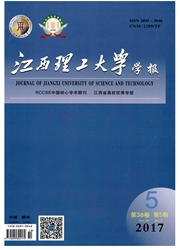

 中文摘要:
中文摘要:
文章选用FeCl2与FeCl3浸渍颗粒活性炭制成复合材料(GAC-Fe(Ⅱ)、GAC-Fe(Ⅲ)),并用扫描电镜(SEM)对复合材料GAC-Fe(Ⅱ)、GAC-Fe(Ⅲ)进行表征.研究比较两种复合材料在不同初始浓度和不同DH条件下去除水中溴酸盐BrO3-的效果,使用吸附等温模型和吸附动力学模型对实验结果进行分析。并探讨其反应机理.结果表明,初始浓度16.7mg/LGAC-Fe(Ⅲ)效果优于GAC-Fe(Ⅱ),BrO3-去除率可达98%;去除率随pH值3-9的升高而下降;吸附等温实验表明.Langmuir吸附等温式能更好的描述材料对BrO3^-的吸附过程及材料的吸附效果;吸附动力学实验表明材料去除BrO3^-更符合准二级吸附动力学模型.
 英文摘要:
英文摘要:
Composite materials (GAC - Fe (Ⅱ), GAC - Fe (Ⅲ)) are made from FeCl2 and FeCl3 impregnated granular activated carbon (GAC-Fe) in the experiment and are characterized by SEM. Two kinds of composite material removal bromate in different initial bromated concentration and pH conditions are compared; the study results are analyzed by adsorption isothermal model and the adsorption dynamics model, and its reaction mechanism is discussed. The results show that at initial bromate concentration 16.7 mg/L condition, the GAC- Fe(Ⅲ) is better than GAC-Fe(Ⅱ), the removal rate is 98 %; GAC-Fe(Ⅱ), GAC-Fe(Ⅲ) removal rate of BrO3- decreases along with the increase of pH 3-9. Adsorption isotherm experiments show that the Langmuir adsorption isotherm could fit the experimental data well; the adsorption kinetic studies show that the material removal of BrO3 could fit the second-order dynamic adsorption model.
 同期刊论文项目
同期刊论文项目
 同项目期刊论文
同项目期刊论文
 期刊信息
期刊信息
